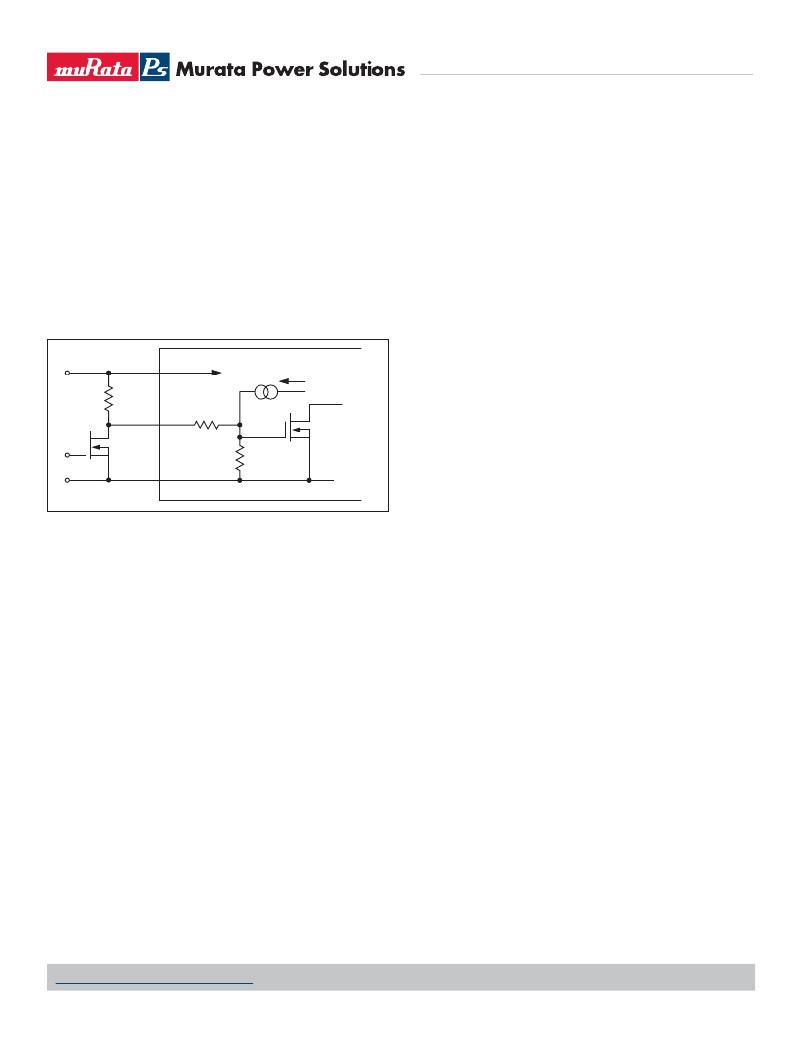- 您现在的位置:买卖IC网 > Sheet目录868 > LSN2-T/30-D12-C (Murata Power Solutions Inc)CONV DC/DC 150W 30A 0.8-5V SIP
�� �
�
 �
�LSN2-T/30-D12� Series�
�DOSA-SIP,� 30A� POL� DC/DC� Converters�
�Power-up� Sequencing�
�If� a� controlled� start-up� of� one� or� more� LSN2-T/30-D12� Series� DC/DC� converters�
�is� required,� or� if� several� output� voltages� need� to� be� powered-up� in� a� given�
�sequence,� the� On/Off� control� pin� can� be� driven� with� an� external� device� as� per�
�Figure� 4.�
�Output� Overvoltage� Protection�
�LSN2-T/30-D12� SIP� Series� DC/DC� converters� do� not� incorporate� output�
�overvoltage� protection.� In� the� extremely� rare� situation� in� which� the� device’s�
�feedback� loop� is� broken,� the� output� voltage� may� run� to� excessively� high� levels�
�(V� OUT� =� V� IN� ).� If� it� is� absolutely� imperative� that� you� protect� your� load� against�
�any� and� all� possible� overvoltage� situations,� voltage� limiting� circuitry� must� be�
�provided� external� to� the� power� converter.�
�+INPUT�
�Output� Reverse� Conduction�
�Many� DC/DCs� using� synchronous� recti?cation� suffer� from� Output� Reverse�
�Conduction.� If� those� devices� have� a� voltage� applied� across� their� output� before�
�a� voltage� is� applied� to� their� input� (this� typically� occurs� when� another� power�
�supply� starts� before� them� in� a� power-sequenced� application),� they� will� either�
�fail� to� start� or� self� destruct.� In� both� cases,� the� cause� is� the� “freewheeling”� or�
�“catch”� FET� biasing� itself� on� and� effectively� becoming� a� short� circuit.�
�LSN2-T/30-D12� SIP� DC/DC� converters� do� not� suffer� from� Output� Reverse�
�Conduction.� They� employ� proprietary� gate� drive� circuitry� that� makes� them�
�immune� to� moderate� applied� output� overvoltages.�
�Thermal� Considerations� and� Thermal� Protection�
�The� typical� output-current� thermal-derating� curves� shown� below� enable�
�designers� to� determine� how� much� current� they� can� reliably� derive� from� each�
�model� of� the� LSN2-T/30-D12� SIPs� under� known� ambient-temperature� and� air-�
�?ow� conditions.� Similarly,� the� curves� indicate� how� much� air� ?ow� is� required� to�
�reliably� deliver� a� speci?c� output� current� at� known� temperatures.�
�4.75K�
�ON/OFF�
�1K�
�PWM�
�Enable�
�The� highest� temperatures� in� LSN2-T/30-D12� SIPs� occur� at� their� output�
�inductor,� whose� heat� is� generated� primarily� by� I� 2� R� losses.� The� derating� curves�
�were� developed� using� thermocouples� to� monitor� the� inductor� temperature� and�
�COMMON�
�10K�
�varying� the� load� to� keep� that� temperature� below� +110°C� under� the� assorted�
�conditions� of� air� ?ow� and� air� temperature.� Once� the� temperature� exceeds�
�+115°C� (approx.),� the� thermal� protection� will� disable� the� converter.� Automatic�
�restart� occurs� after� the� temperature� has� dropped� below� +110°C.�
�As� you� may� deduce� from� the� derating� curves� and� observe� in� the� ef?ciency�
�Figure� 4.� On/Off� Control� Using� An� External� Driver�
�(Typical� circuit)�
�Output� Overcurrent� Detection�
�Overloading� the� power� converter’s� output� for� an� extended� time� will� invariably�
�cause� internal� component� temperatures� to� exceed� their� maximum� ratings�
�and� eventually� lead� to� component� failure.� High-current-carrying� components�
�such� as� inductors,� FET’s� and� diodes� are� at� the� highest� risk.� LSN2-T/30-D12�
�SIP� Series� DC/DC� converters� incorporate� an� output� overcurrent� detection� and�
�curves� on� the� following� pages,� LSN2-T/30-D12� SIPs� maintain� virtually� constant�
�ef?ciency� from� half� to� full� load,� and� consequently� deliver� very� impressive�
�temperature� performance� even� if� operating� at� full� load.�
�Lastly,� when� LSN2-T/30-D12� SIPs� are� installed� in� system� boards,� they� are�
�obviously� subject� to� numerous� factors� and� tolerances� not� taken� into� account�
�here.� If� you� are� attempting� to� extract� the� most� current� out� of� these� units� under�
�demanding� temperature� conditions,� we� advise� you� to� monitor� the� output-�
�inductor� temperature� to� ensure� it� remains� below� +110°C� at� all� times.�
�shutdown� function� that� serves� to� protect� both� the� power� converter� and� its� load.�
�If� the� output� current� exceeds� it� maximum� rating� by� typically� 50%� or� if� the�
�output� voltage� drops� to� less� than� 98%� of� it� original� value,� the� LSN2-T/30-D12’s�
�internal� overcurrent-detection� circuitry� immediately� turns� off� the� converter,�
�which� then� goes� into� a� “hiccup”� mode.� While� hiccupping,� the� converter� will�
�continuously� attempt� to� restart� itself,� go� into� overcurrent,� and� then� shut� down.�
�Once� the� output� short� is� removed,� the� converter� will� automatically� restart� itself.�
�www.murata-ps.com/support�
�MDC_LSN2-T/30-D12� Series.C01� Δ� Page� 7� of� 16�
�发布紧急采购,3分钟左右您将得到回复。
相关PDF资料
LSS-T/10-W12-C
CONV DC/DC 60W 10A .6-6V SIP
LTM4600HVIV#PBF
IC DC/DC UMODULE 10A 104-LGA
LTM4600IV#PBF
IC DC/DC UMODULE 10A 104-LGA
LTM4601AHVEV#PBF
IC DC/DC UMODULE 12A 133-LGA
LTM4601AIY#PBF
IC DC/DC UMODULE 12A 133-BGA
LTM4602IV#PBF
IC DC/DC UMODULE 6A 104-LGA
LTM4603HVEV#PBF
IC DC/DC UMODULE 6A 118-LGA
LTM4603IV#PBF
IC DC/DC UMODULE 6A 118-LGA
相关代理商/技术参数
LSN2-T/30-D12G-C
功能描述:DC/DC转换器 12Vin 0.8-5Vout 30A 150W Power Good Out
RoHS:否 制造商:Murata 产品: 输出功率: 输入电压范围:3.6 V to 5.5 V 输入电压(标称): 输出端数量:1 输出电压(通道 1):3.3 V 输出电流(通道 1):600 mA 输出电压(通道 2): 输出电流(通道 2): 安装风格:SMD/SMT 封装 / 箱体尺寸:
LSN2-T/30-D12N-C
功能描述:DC/DC转换器 12Vin 0.8-5Vout 30A 150W Neg polarity RoHS:否 制造商:Murata 产品: 输出功率: 输入电压范围:3.6 V to 5.5 V 输入电压(标称): 输出端数量:1 输出电压(通道 1):3.3 V 输出电流(通道 1):600 mA 输出电压(通道 2): 输出电流(通道 2): 安装风格:SMD/SMT 封装 / 箱体尺寸:
LSN2-T/30-D12NG-C
功能描述:DC/DC转换器 12Vin 0.8-5Vout 30A 150W PowerGood NegPl RoHS:否 制造商:Murata 产品: 输出功率: 输入电压范围:3.6 V to 5.5 V 输入电压(标称): 输出端数量:1 输出电压(通道 1):3.3 V 输出电流(通道 1):600 mA 输出电压(通道 2): 输出电流(通道 2): 安装风格:SMD/SMT 封装 / 箱体尺寸:
LSN2-T/6-C
制造商:CANDD 制造商全称:C&D Technologies 功能描述:Non-isolated, DOSA-SIP, 6/10/16A Selectable-Output DC/DC Converters
LSN2-T/6-D12
制造商:CANDD 制造商全称:C&D Technologies 功能描述:Non-isolated, DOSA-SIP, 6/10/16A Selectable-Output DC/DC Converters
LSN2-T/6-D12-C
功能描述:DC/DC转换器 19.8W 12V/0.75-5V 6A RoHS:否 制造商:Murata 产品: 输出功率: 输入电压范围:3.6 V to 5.5 V 输入电压(标称): 输出端数量:1 输出电压(通道 1):3.3 V 输出电流(通道 1):600 mA 输出电压(通道 2): 输出电流(通道 2): 安装风格:SMD/SMT 封装 / 箱体尺寸:
LSN2-T/6-D12G-C
功能描述:DC/DC转换器 19.8W 12V/0.75-5V 6A RoHS:否 制造商:Murata 产品: 输出功率: 输入电压范围:3.6 V to 5.5 V 输入电压(标称): 输出端数量:1 输出电压(通道 1):3.3 V 输出电流(通道 1):600 mA 输出电压(通道 2): 输出电流(通道 2): 安装风格:SMD/SMT 封装 / 箱体尺寸:
LSN2-T/6-D12N-C
功能描述:DC/DC转换器 19.8W 12V/0.75-5V 6A
RoHS:否 制造商:Murata 产品: 输出功率: 输入电压范围:3.6 V to 5.5 V 输入电压(标称): 输出端数量:1 输出电压(通道 1):3.3 V 输出电流(通道 1):600 mA 输出电压(通道 2): 输出电流(通道 2): 安装风格:SMD/SMT 封装 / 箱体尺寸: